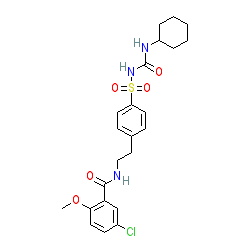GtoPdb is requesting financial support from commercial users. Please see our sustainability page for more information.
|
Synonyms: Amglidia® | Diabeta® | glyburide | Glynase®
glibenclamide is an approved drug (FDA (as glyburide, 1984), EMA (2018))
Compound class:
Synthetic organic
Comment: A sulfonylurea family drug inhibiting sulfonylurea receptor 1 (ABCC8)/Kir6.2 (KCNJ11). Glibenclamide induced blockade of SUR1-TRPM4 channels reduces inflammatory markers and improves clinical symptoms in mouse experimental autoimmune encephalomyelitis (EAE), and may be of relevance in multiple sclerosis as SUR1-TRPM4-expressing lesions from MS provide a potentially disease modiifying target [12].
Ligand Activity Visualisation ChartsThese are box plot that provide a unique visualisation, summarising all the activity data for a ligand taken from ChEMBL and GtoPdb across multiple targets and species. Click on a plot to see the median, interquartile range, low and high data points. A value of zero indicates that no data are available. A separate chart is created for each target, and where possible the algorithm tries to merge ChEMBL and GtoPdb targets by matching them on name and UniProt accession, for each available species. However, please note that inconsistency in naming of targets may lead to data for the same target being reported across multiple charts. ✖
View more information in the IUPHAR Pharmacology Education Project: glibenclamide |
|
|||||||||||||||||||||||||||||||||||
| No information available. |
Mechanism Of Action and Pharmacodynamic Effects  |
| The sulfonyurea drugs appear to bind sulfonylurea receptors and it has been shown experimentally that tritiated glibenclamide can be used to pull out a 140 kDa protein identified as SUR1 (now known as ABCC8) [37]. SUR2 (ABCC9) has also been identified [20]. However, this is not the full mechanism of action and the functional channel has been characterised as a hetero-octamer formed by four SUR and four Kir6.2 subunits, with the Kir6.2 subunits forming the core ion pore and the SUR subunits providing the regulatory properties [33]. Co-expression of Kir6.2 with SUR1, reconstitutes the ATP-dependent K+ conductivity inhibited by the sulfonyureas [20]. |
External links  |
|
For extended ADME data see the following: Electronic Medicines Compendium (eMC) Drugs.com European Medicines Agency (EMA) |









